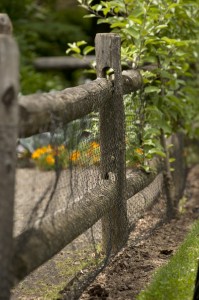Tip of the Week: More on Vegetable Garden Design
Posted in Exhibitions, Gardening Tips, The Edible Garden on June 28 2010, by Sonia Uyterhoeven
 |
Sonia Uyterhoeven is Gardener for Public Education. Join her each weekend for home gardening demonstrations on a variety of topics in the Home Gardening Center. |
 Last week I blogged about the historic and design aspects of ornamental vegetable gardens. This week I take a look at some of their basic features.
Last week I blogged about the historic and design aspects of ornamental vegetable gardens. This week I take a look at some of their basic features.
Many traditional kitchen gardens have some kind of boundary or enclosure that not only separates the garden from its surroundings but often provides a practical barrier to keep out unwanted pests. Classic boundaries include brick walls, stonewalls, wooden fences, wattle or woven fences, and hedges.
A simple split-rail wooden fence lined with chicken wire to keep out rabbits surrounds the vegetable garden in the Botanical Garden’s Home Gardening Center (see photo). “A flat-top picket fence would give it a Colonial feel, while a more open and rustic setting could be created by a zigzag wooden fence,” says Chris from a fence company in Louisville, KY. The hardscape of the garden will help set the mood and contribute to the overall design. Enclosure creates a sense of intimacy and gives a framework to your garden.
With the boundary in place, consider how you will traverse the garden’s interior. Paths can be made of brick, stone, gravel, straw, bark chips, or grass. Vegetable gardens are tended constantly, and it is important that the size of the beds and paths are practical and comfortable. Some paths may need to accommodate a wheelbarrow. Also think of seating or dining areas where you can relax and enjoy your hard work.
The beds in an ornamental vegetable garden are often edged. Raised beds are very common since they are easy to work and provide excellent drainage. Ground beds can be edged with bricks, stones, wattle fencing, dwarf hedges, or edible borders. Herbs and annuals—particularly lavender, winter savory, parsley, sage, marigolds, pansies, and scented geraniums—make excellent borders that can be edible as well as ornamental.
The layout of a kitchen garden should be practical yet aesthetically pleasing and adventurous. Garden writers Jan and Michael Gertley recommend looking at the patterns on quilts as inspiration for the layout of beds and the formation of an overall plan. Beds can be made in the shape of squares, rectangles, circles, triangles, or in any geometric pattern that suits your fancy.
If this seems too ambitious, a more sophisticated design can be created in your selection of vegetables, herbs, and flowers. Sit down with tracing paper, graph paper, ruler, compass, and eraser, and sketch a design.
Once you have determined the bed shapes and sizes, it is time to turn to your catalogs and fill in the design. Remember to always plant what you like to eat. The point of growing vegetables is to enjoy eating them.


I love the wooden fences with chicken wire. So classic! I have trellis on my garden, its a space saving. I usually use it for all vining plants. My cucumber grew long and straight in the trellis. It also leave space for the other plants.